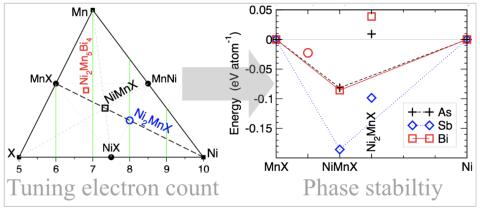
(b) Energy (stability) of hH NiMnX relative to fcc Ni and MnX (X = As, Sb, Bi).
*Predicts stable half-metals like (Cu0.25Ni0.75)MnBi.
Scientific Achievement
Established simple electron-count, chemical-alloy design guide to enhance half-metal behavior, accelerating discovery of new spintronic systems for use in memory and nano-electronic devices.
Significance and Impact
Our guide for half-metallicity and its energy-gap enables fast electronic engineering for spintronic applications, and a feature to train machine-learning models for find new alloys.
Research Details
- From first-principles, electronic-structure methods addressed substitutional alloying and electron-count correlations.
- Predicted existence of thermodynamically stable, new half-metallic multicomponent systems.
N.A. Zarkevich, P. Singh, A.V. Smirnov and Duane D. Johnson, “Effect of substitutional doping and disorder on the phase stability, magnetism, and half-metallicity of Heusler alloys,” Acta Materialia 225, 117477 (2022).
